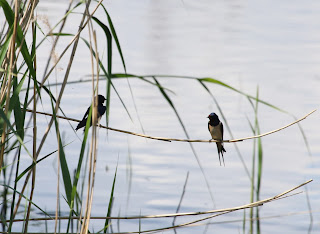The other day I returned to the northern eastern part of the
Drömling. The weather was hot and sunny making photography difficult because the light was extremely stark. I was hoping to find some Ortolan Buntings which frequent this drier and more open habitat. I saw one in this area last year but they are scarce and not easy to find.
 |
| Drömling - North east |
 |
| Drömling from the Schwarze Brücke - Golden Oriels! |
My entry point was the small hamlet of Kaiserwinkel which you can see in the middle right hand sector of the map. Access is quite easy as one can take a car along some good agricultural tracks right up to the main area of interest. The recently rebuilt Schwarze Brücke
is a good place to park. Spring is, to all intents and purposes, now over and we are now well into the breeding season. Nevertheless, lots of birds were singing - especially Yellowhammers of which there are plenty. The Ortolan Bunting song sounds, to my ears at least, like a softer foreshortened version of their Yellowhammer cousin and in my experience it is worth checking all of the latter just in case.
 |
| Ortolan Bunting - against the sun! |
As luck would have it, I quickly located an Ortolan
signing from the top of a tall tree. Unfortunately the bird was right against
the sun making good observation of the species’ diagnostic
features difficult. However, the combination of song, warm orange underparts
and greenish head, was good enough for me. Its a nice feeling seeing a bird you've set out to see, especially when they are scarce, but it does rather fill you with that feeling of 'OK, well what next?'
 |
| Drömling - 'Kernzone'. Note drier more open habitat. |
 |
| Cuckoo - Drömling |
Puckle and I ventured into the 'Kernezone'. The habitat here is more open than the southern sector and contains large extensive meadows of grass filled with flowers - perfect for Corncrakes if any were calling. I quickly came across a Garden Warbler signing from deep within a bush. How ever long I waited, he refused to come out long enough for me to take a photograph. I found a second, similarly skulking, 10 metres further on which, seeing that they must have been signing for territory, seems rather strange. Rather more obliging on the visibility front, were the cuckoos of which I counted 10 by the end of my visit. They are truly abundant here and must run their 'hosts' ragged. A family of Stonechats was nice to see as were dozens of Red Kites throwing themselves around the blue sky over the meadows. I heard at least 6 Great Reed Warblers all signing from the small clumps of reed in the ditches besides the path. Most of them seemed to be signing half heartedly almost as if they'd given up finding a mate.
 |
| Park sign - not exactly the RSPB. |
 |
| Stonechat - Drömling |
 |
Red Kite - Drömling
|
It was getting towards mid day now and becoming really hot. There was a discernable reduction in the amount of bird activity. Somes hares trotted up the path towards us but even Puckle wasn't interested prefering to find a nice shaddy spot to hide - so much for a hunting pedigree! I heard a second Ortolan fly overhead and saw a group of Cranes descending into an adjacent field. Following my last visit here I have checked their status in the Drömling and it seems that there is a small breeding population here. Could this have been a family group mooching around? A White Stork flew by - they also breed locally but not in large numbers.
 |
| Lazy dog! - Drömling |
 |
| 2 of 8 Cranes with their undercarriage down - Drömling |
Here's the day's list - Mute Swan, Mallard, Grey Heron, White Stork, Red Kite (6), Buzzard, Crane (8), Woodpigeon, Cuckoo (10), Skylark, Swallow, Tree Pipit, Pied Wagtail, Stonechat, Blackbird, Marsh Warbler, Great Reed Warbler (6), Whitethroat, Garden Warbler (2), Chiffchaff, Goldcrest, Blue Tit, Great Tit, Golden Oriole, Red-backed Shrike (10), Raven (3), Starling, Tree Sparrow, Yellowhammer, Linnet and Ortolan Bunting (2). Not brilliant, but as I said at the beginning of this post, spring is vorbei and somnolent summer seems to have arrived.
 |
| White Stork - Drömling |
 |
| Linnet - Drömling |



















































